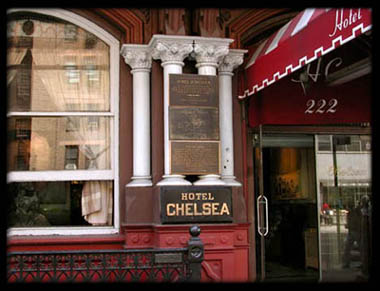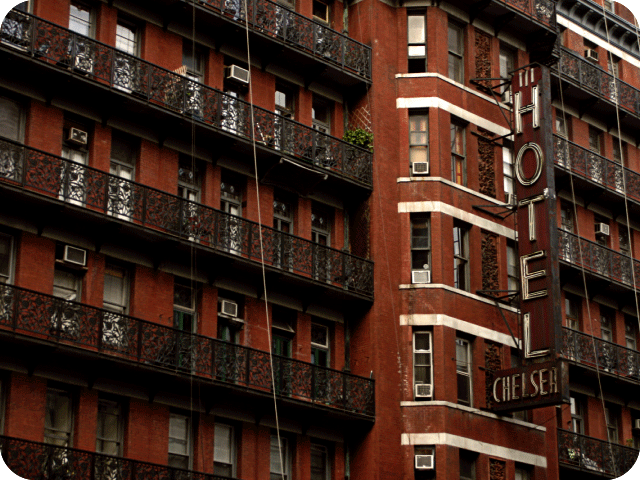222 West 23rd Street
Dylan Thomas died there in 1953 and Sid killed Nancy there in 1978.
The twelve-story red-brick building that now houses the Hotel Chelsea was built in 1883 as a private apartment co-op that opened in 1884; it was the tallest building in New York until 1899.

the lobby
At the time Chelsea, and particularly the street on which the hotel was located, was the center of New York's Theater District. However, within a few years the combination of economic worries and the relocation of the theaters bankrupted the Chelsea cooperative.
In 1905, the building was purchased and opened as a hotel.
And since 1946, the hotel has been managed by the Bard family, and until recently was run by 72-year-old Stanley Bard who took over as managing director from his father in 1955.

But on June 18, 2007 the hotel's board of directors ousted Bard as the hotel's manager. Marlene Krauss, a doctor who is the chief executive of KBL Healthcare Ventures, and David Elder, one of the heirs of an original owner who lives in California, replaced Stanley Bard with management company BD Hotels NY, L.L.C.

room #603
No two rooms in the hotel are the same.
Owing to its long list of famous guests and residents, the hotel has an ornate history, both as a birth place of creative modern art and punctuated by tragedy catching the public eye.
Sir Arthur Clarke wrote 2001: A Space Odyssey while staying at the Chelsea.
The hotel has always been a center of artistic and bohemian activity and it houses artwork created by many of the artists who have visited. The hotel was the first building to be listed by New York City as a cultural preservation site and historic building of note.

People who live/have lived at the Hotel Chelsea:
During its lifetime Hotel Chelsea has provided a home to many great writers and thinkers including Mark Twain, O. Henry, Dylan Thomas lived & died there, Sir Arthur Clarke wrote 2001: A Space Odyssey while staying there, William Burroughs, Arthur Miller, Gore Vidal, Tennessee Williams, Allen Ginsberg, Jack Kerouac, Simone de Beauvoir, Jean-Paul Sartre, Thomas Wolfe, Charles Bukowski and René Ricard. Charles R. Jackson, author of The Lost Weekend, committed suicide in his room on September 21, 1968.

Room #822
Much of Hotel Chelsea's history has been colored by the musicians who have resided there. Some of the most prominent names include Tom Waits, Patti Smith, Dee Dee Ramone, Henri Chopin, John Cale, Édith Piaf, Joni Mitchell, Bob Dylan, Janis Joplin, Jimi Hendrix, Sid Vicious, Richard Hell, Ryan Adams, Rufus Wainwright, Leonard Cohen and Anthony Kiedis.


Room 324
"Only thanks to the imigration of artists, creative and critical spirits to the Village around the turn of the century, its charm could have been preserved. In the fifties, the Village became attractive for the beatnicks. In the sixties, the hippies came. In the seventies and eightees, it was the Rock'n'Rollers and everybody who wanted to be hip who made Greenwich Village and neighboring Chelsea symbols of the New York way of life. One of the particular spots is the Chelsea Hotel, meanwhile under national protection. This place is talking more about popular culture and its artists than any other spot in the Village.
The Chelsea was famous even back at a time when Mark Twain was living in one of its rooms. Thomas Wolfe and Arthur Miller have been living and writing there. Miller, who stayed six years at the Chelsea described the famous artist's hotel like this: This hotel does not belong to America. There are no vacuum cleaners, no rules and shame...it's the high spot of the surreal. Cautiously, I lifted my feet to move across bloodstained winos passing out on the sidewalks--and I was happy. I witnessed how a new time, the sixties, stumbled into the Chelsea with young, bloodshot eyes.
Until 1884, the Chelsea Hotel was the highest building in New York City. Today it is burried somewhere in the suburbia of Manhattan. The glamor of ancient time has been nagged away by the destruction done by the years. Only the main entrance with its memorial plates is reminding us of the great past of the hotel. The lobby is resembling an art gallery consisting of objects that sometimes were kept by the hotel management in lieu of payment for a rent long overdue.
The reception desk looks like straight out of an old black & white Hollywood movie. Both lifts seem to move in slow motion up and down the ten-story building. Sometimes, the inside of the hotel looks like a barracs. But holes in the floors, sqeeking waterpipes or breathing heatpipes only add to the ambiente of the hotel. Nonchalance is being cultivated in this place. Luxury is unwanted. Usefulness, atmosphere and non-conformism are dominating.
Pompousness is looked down upon, nonetheless there is tidyness all over the place. In the last five years, a lot of money has been spend upon the restauration of the victorian-gothic building with its many oriels.
Even today, only 100 of the Chelsea's 400 'units' are available to 'normal' New York visitors, the rest of them is occupied by permanent residents. The most beautiful of all (# 600) is a luxury suite which has a marble floor and a bronze fireplace and is currently rented to the gay couple writing love stories under the moniker "Judith Gould". If you want to stay at the Chelsea, you'd be better adviced to book at least two months ahead, even if it's only a ordinary room. You rather pay for the famousness of the hotel than for the rooms themselves. You can get a room facing the street at about $ 140 and the Chelsea is highly recommended for people who love something special.
Every room at the Chelsea tells its own story. In # 205, welsh poet Dylan Thomas, who reputedly inspired young Zimmerman to change his name to Bob Dylan, fell into a fatal coma after having 18 whiskies in a row. # 100 was once occupied by Sid Vicious, bass player with The Sex Pistols, and his girlfriend Nancy Spungeon. On the morning of October 11, 1978 Spungeon was found in the bathroom, stabbed to death. Viscious, arrested under suspicion of murder, died shortly thereafter of a heroin overdose. Jimi Hendrix lived, loved and experimented here, with drugs and other things. Janis Joplin did not only have a love affair with Southern Comfort but also had a short liaison with Leonard Cohen. The canadian rock poet, too, loved the hotel: It's one of those hotels that have everything that I love so well about hotels. I love hotels to which, at four a.m., you can bring along a midget, a bear and four ladies, drag them to your room and no one cares about it at all.
His song Chelsea Hotel is not only a remembrance of past loves with the likes of Janis Joplin or Nico, it's also a declaration of love towards the hotel: I remember you well in the Chelsea Hotel/ You were taking so brave and so free/ Giving me head on the
unmade bed/ While the limousines wait in the street/ Those were the reasons and that was New York/ I was running for the money and the flesh/ That was called love for the workers in song/ Probably still is for those of us left.
The list of Big Names of literature, music or the arts scene who stayed at the Chelsea is seemingly bottomless: Jane Fonda, Jackson Pollock, Brendan Behan, Sarah Bernhardt to name but a few. They all encountered tragedies and comedies. They wrote short stories, movie scripts and novels and painted their pictures. They completed their movies within their heads, long before the actual shooting took place. Some of them had fatal endings...
For many, the Chelsea was a hideout or regular adress for many years, remembers Stanley Bard, who's been the hotel manager for almost 40 years now. Some of them lived here over decades. It was only recently that punk-icon Patti Smith moved out.
Stanley Bard appears to be friendly but keeps distance, on the other hand he's happy about reminicing every once in a while and he points out the bookcase in his office. I'm collecting every book that has been written in my hotel, he says taking out Thomas Wolfe's novel You Can't Go Home. Many things have happened here, he continues. Jim Morrison, Hendrix and Janis Joplin were having their drug parties here. Today, there's a 'No Smoking' sign in the hotel lobby.
For many years, Bob Dylan used to live in suite # 2011, # 411 was Janis Joplin's suite. Over the years, Leonard Cohen has lived in many rooms. I like to think of him, back then. He was one of the very few calm ones in these tumultous times. But perhaps his restlessness was better hidden than that of the others. Most of his time in New York in the sixties he was living at # 424.
But Bard refuses to talk about the mysterious Viscious/Spungeon murder case. That's a different story, he says but he's proud of Andy Warhol's love for the hotel. In the 60s, Warhol and Nico have done a movie, Chelsea Girl, at the hotel. All in all it has been a turbulent time back then, Stanley Bard resumes and wistfully finishes, I don't want to have missed any moment in the life of the Chelsea Hotel.
There's hardly been an artist who has lived in the Chelsea that was not in some way captured by its flair, says Patti Smith. Of course, Leonard Cohen is amongst them and with his song Chelsea Hotel No.2 he not only remembers his former lover Janis Joplin but also puts up a monument to his former hunting trails.
Nonetheless, the song has not been written at the Chelsea. I wrote this for an American singer who died a while ago. She used to stay at the Chelsea, too. I began it at a bar in a Polynesian restaurant in Miami in 1971 and finished it in Asmara, Ethiopia just before the throne was overturned. Ron Cornelius helped me with a chord change in an ealier version, Cohen remarks in the liner notes 'Some Notes On The Songs' of his 1975 Greatest Hits compilation "
Check out Living with Legends: Hotel Chelsea Blog




2 comments:
What are you guys doing? Lifting entire paragraphs???
Hmmm...Interesting. There's a lot of talk about these types of occurances lately:
http://www.leonardcohenfiles.com/chelsea.html
The statement that this was the was the tallest building in New York until 1899 is apparently a mistake although that is also what the Hotel’s own website says. Probably it was meant to say it was the tallest building in New York until 1889. Construction of the New York World Building (also known as the Pulitzer Building) began in October 10, 1889, at 53-63 Park Row and was completed on December 10, 1890. The claimed height of that building was 20 stories and it was the tallest building in New York City for about five years. The statement here is also apparently phrased in terms of the building’s height measured by livable stories because the 284-foot spire of Trinity Church was taller.
As for the building being built in 1883 as a private apartment co-op, that is also true about 34 Gramercy Park, a short walk away on 20th Street and Gramercy Park East, the oldest continuously co-op building in New York.
Michael D. D. White
Noticing New York
http://noticingnewyork.blogspot.com/
Post a Comment